Abstract
With the emergence of non-fungible tokens (NFTs) in blockchain technology, educational institutions have been able to use NFTs to reward students. This is done by automatically processing transaction information and the buying and selling process using smart contract technology. The technology enables the establishment of recognition levels and incentivizes students to receive NFT recognition rewards. According to the Taxonomy Learning Pyramid, learning through hands-on experiences plays a crucial role in attracting students’ interest. In this study, we analyzed the potential for using NFTs in education and the current applications of NFTs in society. We conducted a case study and performed a preliminary investigation of the types of NFT applications in the education industry. We then analyzed different education industries using individual analysis combined with SWOT analysis to understand the impact, value, and challenges of NFT applications. The results revealed 10 educational applications of NFT: textbooks; micro-certificates; transcripts and records; scholarships and rights; master classes and content creation; learning experiences; registration and data collection; patents, innovation, and research; art; payment; and deposit. Finally, ways to reduce the negative impact of education NFTs on the sustainable environment are discussed.
1. Introduction
The global pandemic caused by the COVID-19 virus has been devastating to most industries and countries, and the education sector has also been affected, forcing a shift from face-to-face, on-site education to remote delivery of skills training and academic courses [1]. With the rise of information technology, some emerging intelligent technologies such as artificial intelligence with STEAM (Science, Technology, Engineering, Art, and Math) education [2], affective tutoring technologies [3], emotional intelligence [4], and affective computing [5] to assist education have become an important research topic.
Non-fungible tokens (NFTs) based on a blockchain are a record of ownership of digital assets. An NFT can be considered as a certificate of ownership. NFTs record the ownership of intangible objects and of tangible items [6]. NFTs help address dilemmas when it comes to trading digital contents [7]. Specifically, teachers distribute and sell the teaching materials or books they produce through NFTs. This innovative model helps transform teachers’ knowledge into commercially viable products while avoiding piracy [8,9]. NFTs are an emerging application following cryptocurrencies and the rise of blockchain technology.
However, the types of applications and benefits of NFTs to education are still in need of research. NFTs can automatically process transaction information and buying and selling processes through smart contract technology, and it is irreplaceable, indivisible, and unique [10]. Educational institutions can reward NFT entities by establishing recognition levels through incentives so that students can receive NFT rewards when they are recognized, thus increasing the gamification process [1]. Taxonomy learning pyramid enhances the instructional trajectory by considering learning as a continuous process consisting of six structural blocks: classroom exercises, classroom tutorials, homework and assignments, periodic tests, revision lectures, and final tests. In this study, we analyzed both the possibility of combining NFTs with education and the cases in which NFTs are applied in society, and we compared and analyzed the differences in the application of NFT in education and assessed the advantages and disadvantages.
2. Literature Review
2.1. Education and Teaching Methods
According to previous research [11], advanced pedagogy improves teaching and learning outcomes by increasing interactions between teachers and students through the use of multimedia and technology. Blended teaching and learning follow an integrated approach that combines students’ interests and teachers’ personalities, wherein teachers use their innovative teaching methods to allow students to enjoy freedom in the learning process. Therefore, the application of innovative teaching and learning methods is extremely important. Dale’s theory suggests that learners retain more information by “doing” than they do by “listening” or “reading,” as shown in Figure 1.
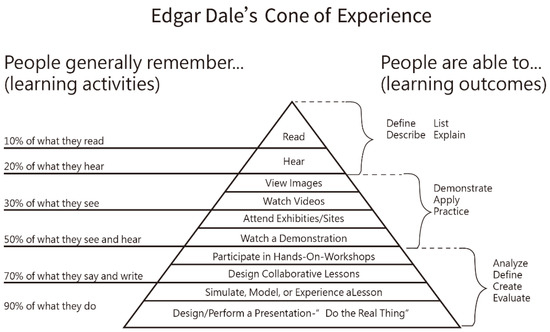
Figure 1.
Edgar Dale’s cone of learning experience. Source: [11].
NFTs are currently flourishing with art collections, although they can be involved in more than that. The current applications of NFTs in education are discussed in the following sections [8,12].
2.2. Textbook
Teachers distribute and sell the teaching materials or books they produce through NFTs. This innovative model helps transform teachers’ knowledge into commercially viable products while avoiding piracy [8]. The sharing economy that relies on a blockchain platform is a new way to create value and distribution channel for various types of digital content such as e-books owned by individuals or organizations. In reality, numerous businesses are increasingly encrypting to protect their products from economic damage resulting from data forgery [13].
2.3. Micro-Credentials
Micro-certificates are a symbol of certification through skill verification. At present, certificates are usually provided in the form of printed or electronic badges. However, the biggest challenge is to verify and evaluate the value of the certificate [14,15]. Students’ educational records can be encrypted, updated, and easily verified by any individual or organization with blockchain technology [9].
In addition, EchoLink is working on a blockchain platform to store verified skills and experiences. This platform stores users’ professional profiles that can be used as a verified resume for the user [16]. Moreover, previous studies pointed out that graduates can find their diploma as a tamper-proof certificate that is strictly preserved and secured on blockchain-based systems of educational institutes [17,18].
2.4. Transcripts and Records
In addition to certificates, school transcripts can be obtained in the form of tokens, which include grades, reports, and annual achievements. If a student wants to view college transcripts, they must pay a fee to the school to get them printed [14]. Blockchain-based systems such as the Ethereum and DISCIPLINA platform were developed to store grades, track student achievements, and propose a system to create verified personal profiles based on academic and professional achievement [16,19]. These personal data can be linked to companies with recruitment needs.
2.5. Scholarships and Entitlements
If scholarships are provided to students in the form of tokens, students can exchange these tokens for online courses, event tickets, resource visits, counseling sessions, and other purposes [19]. Recent studies reported that students can receive rewards in the form of cryptocurrencies, which can be used to purchase goods and services because the universities accept tokens in their coffee shops, canteens, bookstores, and course enrollment [20,21].
2.6. Masterclass and Content Creation
Content creators who are interested in offering courses, curricula, video lectures, etc. can also benefit from NFTs. When content creators develop a course and sell it to a market or university, they can add the option of secondary sales royalties. If the NFT method is used, each transaction is recorded in the blockchain ledger [22]. Thus, publishers can set the commission and royalty for resale [23] and avoid pirated books, and students can easily find the required e-books through electronic data on the books, e.g., the BooksGoSocial website (https://booksgosocial.com/, accessed on 30 March 2022). They can not only buy books on the platform but also resell and publish their own books. Hence, creators and consumers can easily sell and buy digital contents that exist as an NFT. Each NFT is associated with a physical or digital asset that designates the asset’s legal value, ownership, transaction rights, and other attributes [24]. Each NFT that is recorded on a blockchain system will not be tampered with or superseded in the digital encryption ecosystem [25].
In regard to classroom management, an online learning platform helps increase interaction between students and lecturers based on blockchain technology, which helps manage the quality of examinations or student assessments after each course, and it simultaneously improves the quality of system [19]. The blockchain system NOTA (a novel online teaching and assessment scheme using blockchain) can be used for course implementation and can maintain teaching quality and assessment fairness during courses and examination [26].
2.7. Learning Experiences
Learning is achieved not only through grades or accumulated knowledge but also through experience [27,28,29]. For example, the difficulties and solutions encountered by a surgeon during his first surgery, a fireman putting out a fire, and a salesman completing his first sale serve as key learning experiences in these different professions. If NFTs can be combined with these experiences, it may result in lifelong learning. Blockchain technology has opened up a great prospect for integrating academic teaching activities at schools with professional practices [18,19,20,21]. This contributes to a greater educational environment and an educational system that meets the actual needs of society [9].
With a technology platform managed by a blockchain system, students have the opportunity to choose from a variety of courses in the curriculum. By accumulating bitcoins on the system, students actively learn and interact with their lecturers. Blockchain-dependent technology enhances learning by allowing students to apply a range of career skills that help them think critically, work in groups, and solve problems [14].
2.8. Registration and Data Capturing
At present, most students use a student card to prove their identity, and if they want to prove that they are students in other areas, they need to apply to the school for a separate proof of attendance [16]. However, teachers do not have the relevant proof of teaching in a school. Thus, if NFTs are combined with one’s identity, the identity of students and teachers can be marked in the form of NFTs and display detailed information through data of the smart contract, which can prevent identity theft and quickly prove identity [30].
The nature of the peer-to-peer topology in blockchains helps reduce security risks in the education sector. The blockchain’s data are constantly updated during development, and the new cryptographic algorithm is simultaneously sent separately to the other users. These characteristics make personal data difficult to tamper with [18]. Blockchain technology can bring significant benefits to education, including high transparency and security at a low cost, improving student assessment, and improving control of stakeholders’ identification [20].
2.9. Patenting, Innovations, and Research
Patent registration is not only a time-consuming process but is also high cost. Use of NFT has significant potential in the field of intellectual property [31]. It can promote transparency and open up new markets for innovators to effectively commercialize their inventions. With the help of the unique features of blockchain technology, the NFT can provide protection of intellectual properties [32] while the patent holders wait for the government to grant their products more formal protection. Therefore, NFTs in particular and blockchain in general will make it easier to buy and sell patents, providing new opportunities for educational institutions, businesses, and inventors to profit from these patents, which are encrypted, stored, and protected on the blockchain system [33].
Some inventors, creators, and experts have lost credit for their work simply because they could not patent it. NFTs can use the blockchain immutability principle to provide credit to the owner [34] and embed the metadata and parameters of this invention into irreplaceable tokens. For example, in 2021, UC Berkeley announced the public tokenization of patents for two Nobel Prize-winning inventions and auctioned off CRISPR-Cas9 gene editing and cancer immunotherapy, which were finally sold successfully for 22 ETH [35].
2.10. Arts
Currently, the creative development and production of art and architecture must consider the reality of life, such as the need to consider the structure in the production of architecture. If NFTs are combined with art, scholars of art, symbolism, and architecture can move their works or ideas into the world of NFT to build, develop, and create more products [22,36], which are irreplaceable assets [37].
The trend of NFT application in the creation of artworks has developed at an unprecedented scale. Based on the integration of art and technology, Wang (2022) [38] showed that NFT artworks have the following features: (1) Decentralized characteristics—on the basis of blockchain technology, artwork creators and purchasers can directly interact with each other instead of depending on an intermediary. This also improves transparency about the lifetime of the artwork. (2) Unique characteristics—the identification of NFT artworks is unique through blockchain’s tamper-proof technology. This feature aims to make artworks more valuable because of scarcity in the market while also helping to protect NFT artworks from art forgery. (3) Reselling right—this is a solution to protect the rights of the creators. In detail, artists may be entitled to the benefits associated with the circulation of their artworks. (4) Separation of ownership—with NFTs, the proprietorship can divide the NFT artwork in the form of crypto and can be distributed to the collectors or other stakeholders.
2.11. Payments and Storage
The school needs to make payments, students need to use cash or credit cards to pay, and the school needs to deposit the money in the bank or other places for safekeeping [30]. Thus, the greater the number of monetary transactions, the higher the security risk. A new way of payment called smart contract on blockchain helps improve the efficiency of cash flow administration. Smart contract has been described as a secure and trustworthy platform for automated execution of contract terms and payments without requiring an intermediary (e.g., a bank). This leads to savings in transaction costs and other fees that would otherwise have to be paid to a third party [39].
Regarding the fees and credit transfers in an educational setting, educational institutions can adopt the EduCTX system to activate the transfer process using non-fungible tokens [20]. These tokens are based on blockchain technology, so they are highly secure and reliable. Non-fungible tokens can be used in any digital forms for units of learning such as diplomas, certificates, and courses. Each school should have its own EduCTX system to address the process in a secure way. Likewise, Williams (2019) [40] argued that by paying with a cryptocurrency called Woolf Tokens, which works on the basis of blockchain-based systems, the students would pay lower tuition and the lecturers may receive higher salaries.
2.12. Top 10 NFT Applications Mentioned in the Literature
Combining education through NFTs reduces the need for physical infrastructure and face-to-face interaction and enables students worldwide to transcend geographical barriers, which allows greater participation in education [1]. If education can take advantage of this feature, it will generate a new method of learning for students and teachers. The top 10 NFT applications in education and NFT education products are summarized in Table 1.
Scholars, such as LEDU [8] and DelSignore [12], have put forward their views on the application of NFTs to education. Based on the above discussion, we can infer that education combined with NFT is the most promising method to store transcripts and records. Most scholars have indicated that transcripts and records are easily lost and forgotten, making it impossible to retain data for a long period of time [41,42]. Therefore, if each piece of information is recorded in an NFT, it can be easily accessed and used as an educational file. When interviewing with companies or other schools, information can be quickly displayed without the need to apply for a complicated process. Another promising method is art. As NFTs provide art and collectibles for preservation, they can be combined with education, and students’ creations can be sold as art on the Internet, which increases the visibility and scope of appreciation for students’ works. In the field of education, copyright protection for students’ works and projects is usually overlooked [43]. If these can be combined with NFTs, students’ post-creation rights can be effectively protected.

Table 1.
Top 10 NFT applications in education.
Table 1.
Top 10 NFT applications in education.
| NFT Application Papers: | [A] | [B] | [C] | [D] | [E] | [F] | [G] | [H] | [I] | [J] | [K] | [L] | [M] | [N] | [O] | [P] | [Q] | [R] |
|---|---|---|---|---|---|---|---|---|---|---|---|---|---|---|---|---|---|---|
| Textbooks | ✓ | ✓ | ✓ | ✓ | ||||||||||||||
| Micro-certificate | ✓ | ✓ | ✓ | ✓ | ✓ | ✓ | ✓ | ✓ | ✓ | ✓ | ||||||||
| Transcripts and records | ✓ | ✓ | ✓ | ✓ | ✓ | ✓ | ✓ | ✓ | ✓ | ✓ | ✓ | |||||||
| Scholarships and rights (entitlements) | ✓ | ✓ | ✓ | ✓ | ✓ | ✓ | ✓ | |||||||||||
| Master class and content creation | ✓ | ✓ | ✓ | ✓ | ✓ | |||||||||||||
| Learning experience | ✓ | ✓ | ✓ | ✓ | ✓ | ✓ | ✓ | ✓ | ✓ | |||||||||
| Registration and data collection | ✓ | ✓ | ✓ | ✓ | ||||||||||||||
| Patents, innovation, and research | ✓ | ✓ | ||||||||||||||||
| Art | ✓ | ✓ | ✓ | ✓ | ✓ | ✓ | ||||||||||||
| Payment and deposit | ✓ | ✓ | ✓ | ✓ |
Note: The letter in [ ] denotes a code of the cited references. The symbol ✓ denotes that the NFT application is mentioned in the paper. [A]: [8]; [B]: [12]; [C]: [44]; [D]: [45]; [E]: [46]; [F]: [47]; [G]: [48]; [H]: [18]; [I]: [19]; [J]: [20]; [K]: [14]; [L]: [21]. [M]: [9]; [N]: [40]; [O]: [16]; [P]: [33]; [Q]: [6]; [R]: [30].
The above analysis shows that education combined with NFTs is primarily used for data preservation. In the past, transcripts were provided to students and parents in a paper form, but paper is easily lost or destroyed by external factors such as getting wet or burnt. Later, online transcripts were introduced to provide access to grades and records, which also allowed data to be preserved. However, data cannot be opened and reviewed at different stages due to different locations of accessing grades. The rise of NFT, which provides a platform for complete data retention, has made it easy to retain transcripts.
3. Research Design and Methodology
This study conducted a scoping review and a case study with a preliminary investigation of NFT education applications. In this study, we first conducted a scoping review to analyze the educational applications of NFT based on a review of the literature. Second, we conducted a case study to preliminarily investigate the possibility of combining NFTs with education and to introduce the cases in which NFTs are applied in the current society. Third, this study analyzed the differences before and after the application of NFTs in education as well as their advantages and disadvantages. Finally, this study discussed the idea of NFT application in education based on the aforementioned differences following NFT application and based on its advantages and disadvantages.
This study reviewed papers regarding NFT educational applications published in the ScienceDirect database (SDOS), Science Citation Index (SCI), and Social Science Citation Index (SSCI). The review procedure followed that of a previous study [5] that reviewed technology-assisted topics. Two researchers with NFT experience used the keyword ‘NFT education application’ or ‘NFT educational application’ to collect relevant research papers from the database. Because NFT in educational applications is an emerging topic, we also search all articles in google scholar and the google search engine to broaden our review database.
Based on the abovementioned data collection procedure, the selected NFT educational application papers included articles published in the following academic journals: Applied Sciences, Business Horizons, Computer Applications in Engineering Education, Concurrency and Computation: Practice and Experience, European Journal of Education, Journal of Computing in Higher Education, Journal of Higher Education Policy and Management, Mobile Information Systems, Scientific Reports, and Sustainability. The major contributing countries included England (2), Serbia/Romania/Portugal (2), China (2), United Arab Emirates (1), Mauritius (1), Malaysia (1), Austria (1), Saudi Arabia (1), Spain/USA/England (1), America (1), Hong Kong (1), and Iran/China (1). The number of papers regarding NFT educational applications are shown in Figure 2. Regarding the growing trend of research on NFT in education, only a few studies in the research topic of NFT educational applications were found from before 2020. The number of NFT studies has increased since 2021 due to flourishing of NFT research.
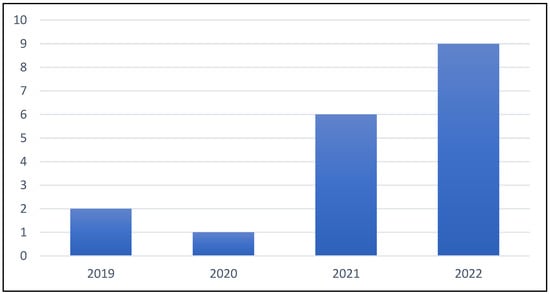
Figure 2.
Number of papers regarding educational applications of NFTs.
This study conducted an analysis of the frequency of keywords from the full text of NFT papers as shown in Table 2. The top five most critical keywords were blockchain (53), NFT (51), educator (44), technology (29), and digital (24). In addition, the terms asset (13), manage (11), and secure (10) were also important concepts in NFT education research. The word clouds based on keyword analyses in the abstract and full text are depicted in Figure 3 and Figure 4, respectively.

Table 2.
Frequency analysis of keywords in NFT education papers (full text).
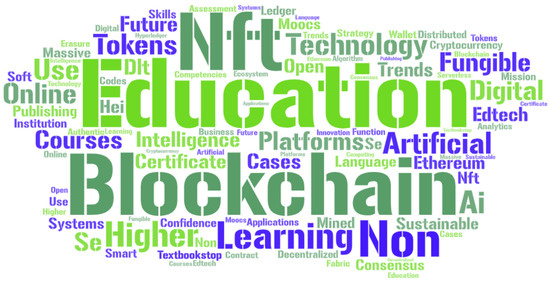
Figure 3.
Abstract word cloud.
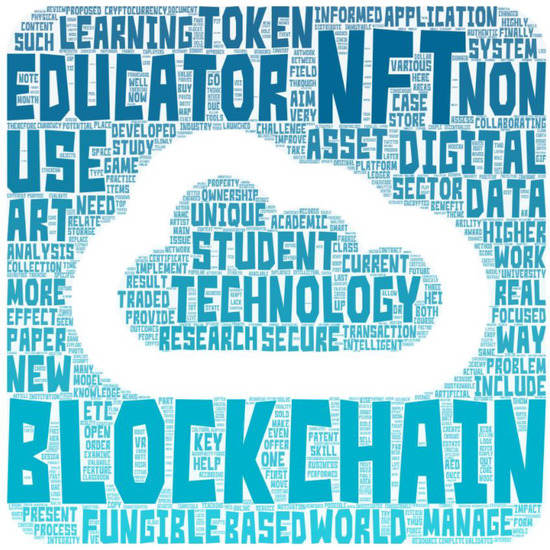
Figure 4.
Full text word cloud.
4. Results
We first conducted a case study with a preliminary investigation of the types of NFT applications in the education industry. We then analyzed different education industries using individual analysis and combined it with SWOT analysis to understand the impact, value, and challenges of NFT applications.
4.1. Current Education versus Education Combined with NFT
Current educational applications of NFT include certificate, transcripts and records, scholarship, content creation, learning experiences, registration, patents, art, and payment and deposits [8,12,44,45,46,47,48]. Comparisons of current educational applications and NFT educational applications are summarized in Table 3. Educators can record certificates, transcripts, and learning records through NFTs and give NFTs to students in the form of scholarships, which students can exchange for courses by using a wide range of applications

Table 3.
Comparison of current education and education combined with NFT.
4.2. NFT Application in Education: Study Abroad
The process of studying abroad is more complicated than studying locally and requires more information such as a university application and visa. Many people give up the opportunity to study abroad if they are not well prepared or do not know enough information about the content. NFT helps guide students through the entire process, informs them of the documents they need to provide, helps them evaluate suitable colleges and universities, and helps them apply for visas (Figure 5).
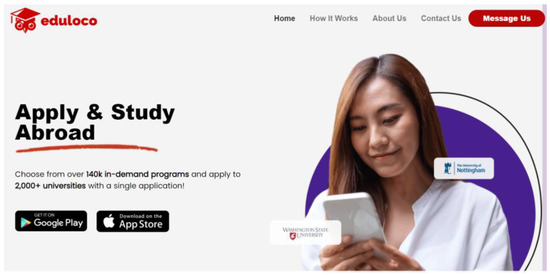
Figure 5.
Eduloco interface. (Source: https://www.eduloco.com/, accessed on 23 April 2022).
4.2.1. Eduloco Value
Eduloco offers students a choice of different subjects and schools, and it provides detailed descriptions of the school of their choice, such as the campus environment, number of students, living expenses, and housing facilities. The website also provides scholarship descriptions of different schools for students in need of reference (Figure 6).
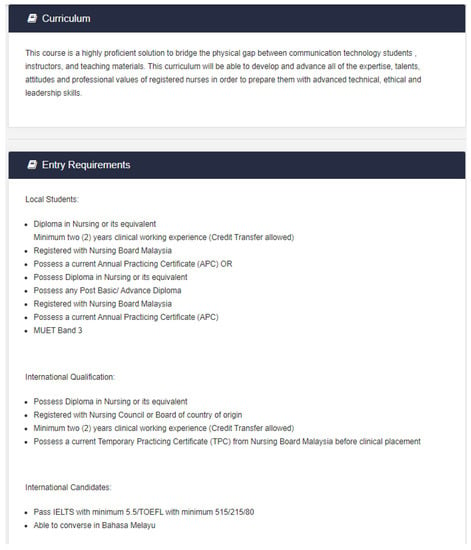
Figure 6.
Interface description. (Source: https://www.eduloco.com/course/bachelor-of-nursing-sciences-hons-open-distance-learning-mode/, accessed on 23 April 2022).
4.2.2. Eduloco Applied in the Metaverse
The outbreak of COVID-19 led to a rapid rise in digital teaching methods. For example, the Korea Advanced Institute of Science and Technology (KAIST) offers its students a 60:40 ratio of live Zoom courses and pre-recorded courses. Students and parents do not need to drive far distances to attend the campus but can conveniently rely on the virtual space in the metaverse [48]. Although it may take some time for craft-based subjects to enter the world of the metaverse at this stage, virtual campuses are gradually being implemented, thus allowing students worldwide to attend classes from home regardless of distance.
4.2.3. Analysis of Strengths and Weaknesses
Before combining NFTs, studying abroad and attending school is necessary for face-to-face interactions and observation of each other’s emotion through expressions or body movements. If students have questions, they can ask the teacher directly during or after class, and the teacher can use the time after class to ask students about their learning status. The disadvantage is that students have to wake up early to go to class and need to make some preparations before they go abroad, including obtaining a passport, daily necessities, and accommodation. Moreover, they may not be able to adapt to the environment in a completely unfamiliar place.
The disadvantage of online learning is that it is not as intimate as physical learning in terms of interaction with classmates. Moreover, because teachers do not know exactly how students are learning, if they are falling asleep in class, or not understanding the course, teachers cannot obtain a good solution. In addition, because students can study better in a familiar environment, they tend to lose the learning experience and foreign culture experience when studying abroad.
4.3. NFT Application in Education: Borrowing and Trading Books
In the past, students who needed to borrow books would go to the library, but it was not easy to find the books they wanted because of the limited number of books in the library. Moreover, not all locations had libraries. With the development of the Internet, books can be presented in an electronic form, which provides more books than libraries. The Internet has enabled students to borrow books at home, which is more convenient than borrowing from libraries.
BooksGoSocial is a website related to book trading, and it differs from traditional book trading in that BooksGoSocial uses the NFT method to sell books through the WAX blockchain, which is a certified carbon-neutral blockchain as seen on the BooksGoSocial website. The WAX blockchain uses 125,000 times less energy per transaction than its closest competitor, solving an environmental problem that exists with other blockchains.
In addition, traditional book sales consider a book sold for a certain price, which can have a high carbon footprint if the book is printed and sent to the purchaser’s home. However, an online trading platform makes the transaction more convenient and faster, as anyone can trade at any time and place and can easily and quickly publish their works on the website (Figure 7).
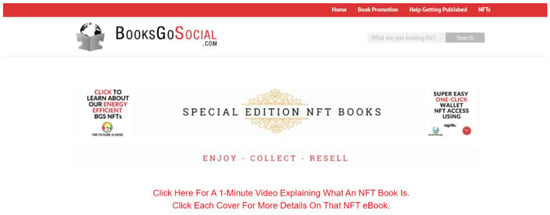
Figure 7.
BooksGoSocial interface. (Source: https://booksgosocial.com/, accessed on 23 April 2022).
4.3.1. BooksGoSocial Value
On this website, users can enjoy additional stories, related video content and other valuable content, read e-books on any device, buy NFT books through their WAX wallet, or sell books through resale. Additionally, buyers with NFT books can visit the private members area, in which users can post comments and reviews, find other unique content, sell NFTs, view details of giveaways and sweepstakes, view collector points used to purchase NFTs, and visit and share the site. Finally, buyers who are not satisfied with their NFT books can get a refund within seven days.
4.3.2. Analysis of Strengths and Weaknesses
One of the reasons why many people would like to buy books is to touch or smell the books when flipping through them, but the disadvantage is that it takes more time to buy. If they are purchased on the Internet, you need to wait for the delivery; thus, if you need books urgently, you need to go to a physical store to look for them or choose a store with faster delivery time.
Using e-books with NFTs, all transactions are conducted on the blockchain, which saves a lot of transaction time, and the ownership of the e-book is protected. Therefore, everyone can post their articles and books on the NFT marketplace. However, the method of book publication may cause some problems, such as the quality of the books is not guaranteed due to the lack of a content and quality check conducted by book publishers and the protection of e-book recreation.
4.4. NFT Application in Education: Youth Technology Development
Recently, Taiwan began using the NFT approach to facilitate youth technical development through the website Bees2be. Around 20,000 different types of bees are available on Bees2be, which aims to celebrate the friendship between Lithuania and Taiwan and to encourage the technical development of youth in rural areas of Lithuania. Bees2be has also set several milestones and will start to achieve them once it reaches the target sales as shown in Table 4.

Table 4.
Percentage target commitment.
4.4.1. Bees2be Value
Bees2be.io is an NFT collection of 20,000 unique little bees that aims to celebrate the friendship between Lithuania and Taiwan and encourage the technological development of rural youth. According to the Bee2be website, some regions in Lithuania are technologically advanced, but many regions are still struggling to provide young people with specific education and opportunities. Bees2be hopes to change this situation through this NFT collection. Bees2be is an NFT-based education and training program aimed at helping children in the Lithuanian region by providing them with the necessary equipment and training to encourage and strengthen their digital literacy and assist in technological development. According to their development strategy, they will begin providing equipment and training to promising children once 50% of the NFTs are sold in order to help these young people better understand digital opportunities, programming, and NFT production. As part of this development strategy, the children will create their own new NFT works, which will be released for subscription after the Bees2be series is sold out.
The Beee2be NFT project is dedicated to providing regional children with the equipment and training they need to encourage and enhance their digital literacy and enable technological development. By purchasing a bee, buyers can ensure that their children have everything they need to learn to program a language and open up more opportunities and possibilities for their future (Figure 8).
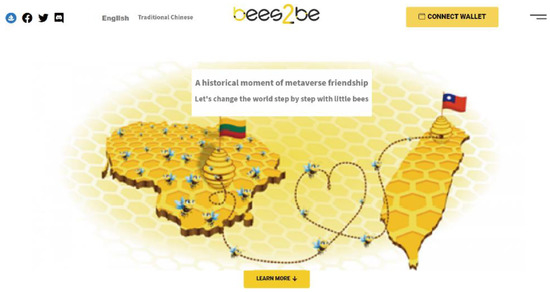
Figure 8.
Bee2be interface. (Source: http://bees2be.io/zh/, accessed on 23 April 2022).
4.4.2. Bees2be Sales Analysis
The price of each Bees2be is ETH 0.18, and the character consists of 13 different accessories: background, chain, earrings, exclusivity, eyes, eyewear, face, fur, hands, legs, mouth, stinger, and wings. The rarer the accessory, the lower the percentage, and the purchase method is provided in the Bees2be website. The work will be presented in Opensea. Currently, 113 people are enlisted to buy a bee character (Figure 9).
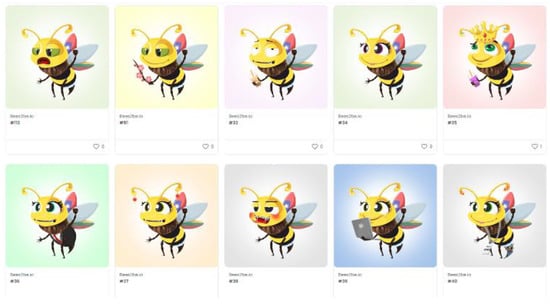
Figure 9.
Bee2be character. (Source: http://bees2be.io/zh/, accessed on 23 April 2022).
4.4.3. Analysis of Strengths and Weaknesses
Before combining with NFT, in traditional education and training programs, buyers only purchased course content services. The advantage of this was being able to know the detailed information of the beneficiaries, such as their region and school. However, a possible disadvantage is that there are no other added values and services.
After combining with NFT, there are other added value to course content. The buyer acquires unique digital bee artwork and receives exclusive membership in a club whose benefits and gifts are set to increase over time. Those purchasing a bee will be supporting a great project to improve the digital literacy of youth in rural Lithuania. However, the disadvantage is that the buyer may not be able to obtain detailed information about the beneficiaries.
4.5. NFT Is Used in Education: Art
OMIA is an online learning platform that offers a variety of courses, such as handicraft and painting, and the creation of art and collectibles is the most common way to present NFTs [10]. According to OMIA’s introduction, the platform has four features: online courses that can be watched at any time, diversified contents that are enjoyable and stress-relieving, masterclasses that are prepared from the beginning to the end, and handcrafted courses with purchased materials.
4.5.1. OMIA Learns the Value of the East and West
OMIA learning is divided into many categories: personal growth, education and learning, health and wellness, handicraft DIY, life hobbies, finance and investment, painting and illustration, photography and art, and workplace skills. Prices range from TWD 300 to TWD 15,000. Recently, due to the epidemic, online learning has become the primary way for children to learn on their own. OMIA’s Learn Something video course platform has launched a special “parent-child online learning” activity to encourage parents to learn with their children. This creates a common topic between children and parents to make parent-child relationships more harmonious. Parents post their children’s achievements on the Internet for everyone to enjoy. Simultaneously, the metaverse and blockchain have also attracted attention, and students can sell their works in the form of NFT. The sales of drawing courses on OMIA’s Learning Stuff platform have doubled compared with that of the same period in the previous year (Figure 10).

Figure 10.
OMIA learning interface. (Source: https://www.omia.com.tw/, accessed on 23 April 2022).
4.5.2. Taiwan Arts University Advancement Universe and Casting NFT
In 2022, to encourage students’ creativity, National Taiwan University of Arts combined NFT with ecology and selected 512 outstanding works under the theme of “Portrait of a Fish” to be sold as public service NFTs. Approximately 50% of the proceeds were donated to young art talents recommended by the National Museum of Art Education, and the other 50% was used for innovative work in technology and art [49], with the hope of motivating more art lovers to publish their works through this method.
4.5.3. Art Revolution Taipei
This exhibit was the first of its kind to present NFT-encrypted art in 2022, allowing everyone to enter and experience the new world of the metaverse. The New Art Revolution Taipei advocates that “Art is not only culture, but also education and promotion, it should never be limited to commercial interests, and the aim is to bring more artists into the world of NFT and to combine it with the metaverse so that artworks can be presented in a more diversified way” [50].
4.5.4. Gust and Her Friends
The abovementioned application of NFT has been combined with artworks, e.g., Gust and her friends, and it differs from other works on the market in that it adopts a lightweight commercial model with a limited edition of 10 rare releases and with unique collector’s significance and value. This artwork was the creation of a six-year-old girl named MIUMIU who transformed her life story into the character “Gust”, and each “Gust” has a special character, such as the love of candy and tooth decay, as well as a symbolic meaning behind the name. The purpose of this is to encourage each child to create their art universe character and to continue utilizing their creative energy [51] (Figure 11).
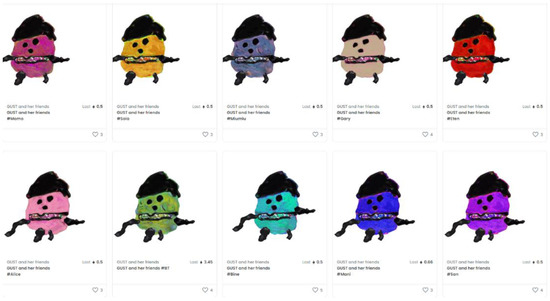
Figure 11.
Gust and her friends. (Source: https://opensea.io/collection/nftboard-today-collection, accessed on 18 March 2022).
According to the introduction on the NFTBoard website, the ultimate goal of Gust is as follows: the first stage is to build children’s meta-universe, the second stage is to create a model that presents generational love, the third stage is to encourage more children to join the project through Gust and Meta Kids Fun, the fourth stage is to hope that these Gust IP and new characters would help the real world through positive images, and finally, the fifth stage is to gather all the characters to build children’s meta-universe (Figure 12).
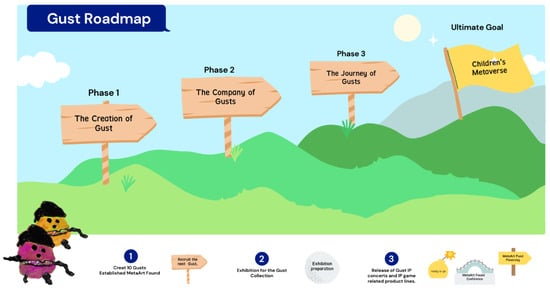
Figure 12.
Gust roadmap. (Source: https://nftboard.today/gust-nft/, accessed on 18 March 2022).
4.5.5. Analysis of Strengths and Weaknesses
The biggest change that followed the combination of art with NFT is the restriction on the artworks’ exhibition. Before the combination of art with NFT, the works were placed in real-world exhibitions, meaning the realistic aspect was considered and the works were touched by buyers for a more realistic experience. The possible disadvantage is pirated copies of the artwork because there is lack of public authentication. Moreover, it is difficult for the creators of the sold works to gain extra revenue.
After the combination of issuing artwork NFT, the works are sold on the NFT marketplace, eliminating the problem of searching the exhibition and reducing the exhibition fee. Thus, the creator is able to create more interesting works, and the works are located in cyberspace all the time. In the meta-universe, artworks are transformed into digital works with NFTs that are able to provide interaction functions with buyers. However, NFT artwork which may the possible problems the other creators to copy, steal, hack, and re-create the works.
4.6. NFT Applied to Educational: Historical Works
The National Palace Museum recently collaborated with Lootex, a Taiwan-based NFT trading platform, and released a series of co-branded NFT graphic art products with eight original illustrators to promote the museum’s collection to the world.
The Palace emphasized that the purpose of issuing NFT merchandise was not the value of the transaction but the educational and promotional significance; they hope to use the secondary creation of cultural relics to attract more people to understand the works and regain an understanding of the content of the relics. They also aimed to play with traditional art in an innovative way through the digital technology network so that the Palace art is widely shared and so the Museum cultural and creative products the derived from national treasures open up a new page and lead the trend of NFT art goods in the country (Figure 13).
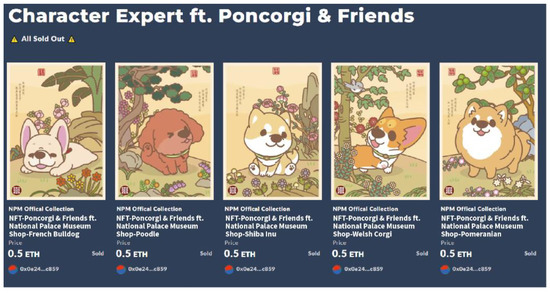
Figure 13.
Lootex secondary creation works. (Source: https://lootex.io/zh-TW/stores/national-palace-museum-shop, accessed on 20 April 2022).
4.6.1. KANDER’S China Royal Art
According to the Opensea platform, KANDER’S is a strategic partnership with Steven Rockefeller’s team. ENFT sis the heirloom art treasures that exist in the world (Figure 14).
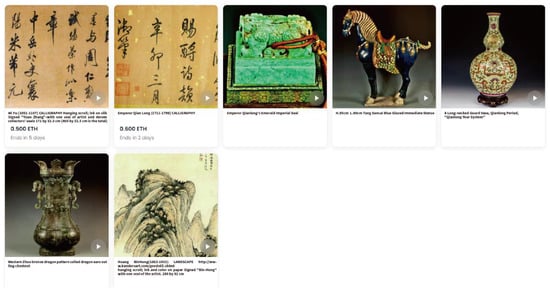
Figure 14.
KANDER’S China royal art treasures. (Source: https://opensea.io/collection/kanders, accessed on 20 April 2022).
4.6.2. Analysis of Strengths and Weaknesses
Before the combination with NFT, the National Palace collection was placed in the same location so that visitors could directly view the complete content of the works on site. Because of the onsite introduction, they could understand the content of the works more comprehensively, but if they wanted to view the works, they had to go directly to the site, which took more time and money. In contrast, after the combination with NFT, visitors could directly view the works on the Internet. However, unlike onsite displays, no introduction of the work is provided by a specialist, which may result in a lack of deep understanding of the work. The greatest advantages of using secondary creation for the sale of the Palace collection are that it can increase the visibility of the work, make the work gathering more interesting, and attract people to buy the product, thereby increasing the revenue. However, because the secondary creation is different from the original style, the buyer may not be able to understand the original appearance of the artwork or the designer’s original design concepts and philosophy.
5. Discussion and Conclusions
Finally, in this section, we present the discussion and conclusions of our study. The first section discusses and summarizes the educational applications of NFT across various industries. The conclusions are described in the next section.
5.1. Discussion
This section summarizes educational applications of NFT among various industries. The different activity styles between current educational applications and NFT educational applications are also discussed.
5.1.1. Education Industry
The comparison of current versus NFT educational activity in education industry are summarizes in Table 5. In study aboard programs, the most remarkable difference between the metaverse and education is whether students and teachers have to physically go to school. If the metaverse is not integrated, students and teachers have to go to the school campus to attend and teach classes, respectively. If combined with the metaverse, students and teachers can easily attend from home. In addition, another challenge for students studying abroad is accommodation. Metaverse integration allows students to continue to live in their original house.

Table 5.
Current versus NFT educational activity (education industry).
Regarding textbooks, the difference between the book trade before and after the combination with NFT is both virtual and physical. Prior to combination with NFT, commercial processes mainly took place in stores, where sellers and buyers met directly to perform services. After combination with NFT, service encounters can be conducted both in stores and e-commerce systems. Before the combination, it was not easy to publish books. However, if combined with the NFT form of sales, everyone can easily publish their work. Because NFT books retain access to copyright, the copyright fee can be set when selling so that when the books are resold, authors can continue to receive royalties, and the publisher has protection and feedback.
Energy consumption is not similar. The energy required before the combination with NFT (from trees and the carbon footprint of transporting books) and after the combination with NFT (from casting costs and electricity consumption) would be very different. What needs to be assessed after the combination with NFT is how to inflict minimum damage to the environment and address the energy consumption problem.
Regarding online courses and training, the combination of educational methods with NFT is more optimal. Once training and education are integrated with NFT, learners not only own the course content but also receive additional values such as Bee2be, which enables learners to help people in Lithuania receive education and training, to obtain a unique bee, and to enjoy the exclusive membership services of the club.
5.1.2. Art Industry
The comparison of current versus NFT educational activity in architecture industry and art industry are summarizes in Table 6. In the architecture industry, architects need to consider the environment and structure when designing a house, but if combined with NFT, their works can be sold in cyberspace through NFTs. Because it is a completely virtual space, there is no need to consider any realistic aspects in the design, which can create more interesting works.

Table 6.
Current versus NFT educational activity (art industry).
In the art industry, before the integration of NFT, a visit to the physical exhibition such as National Palace Museum was required to view the collection. After the integration of NFT, one can directly view it on the Internet. The works have been transformed from purely exhibition, but after using NFT, creators can sell their works on cyberspace, thus increasing the source of revenue.
5.2. Conclusions
NFTs provide several contributions to education, which includes (1) issuance and management of certificates, (2) protection of rights, (3) rewards for teachers, (4) impact beyond the classroom, and (5) privacy control [47]. NFTs are suitable for diplomas, recognition, or certificates and can securely verify academic credentials and achievements. The major benefits of NFTs in education are that NFTs use tokens of blockchain technology thus reducing the possibility of falsification while verifying student records and credits. The other benefit is that the NFT provides an effective tool for tracking students’ learning progress and safely preserving educational data [47].
Educational Applications of the NFT’s Impact on Sustainability
The NFT concept can develop and be involved in a sustainable education game. NFT game-based learning is able to cultivate a player’s motivation to accept the concept of sustainability. Zeedz is one of the sustainable NFT games that provides players the opportunity to collect and grow little monsters and fight in the real world to combat climate change [52]. The player can learn about the reality of climate change and the relevance of three concepts of sustainability: awareness and knowledge of sustainability, financial resource allocation for sustainability, and motivation to become more sustainable.
NFTs themselves do not cause any environmental impact, but an impact on the climate can be caused by how NFTs are minted. NFTs may be harmful to the environment depending on how they are produced (minted), such as in highly energy-intensive minting processes for NFT production or NFT transactions. Minting an NFT usually utilizes the leading blockchain (Ethereum) with a proof-of-work blockchain. To reduce the environment impact, blockchain platforms can use the proof-of-stake operating method to generate NFTs with low energy intensity and without a negative impact on the climate. Other ways to improve sustainability are to use renewable energy, invest in renewable energy, invest in experimental technologies, and choose NFTs minted on proof-of-stake blockchains [53]. Educators can use green or renewable energy to mint educational NFTs. The education NFT issue can select energy-efficient blockchain technology to issue their NFT certification. Notable proof-of-stake blockchains include Ethereum, Solana, Algorand, Cradano, and Tezos. The minted education NFTs can be placed in the well-known NFT marketplace Opensea, which uses Ethereum.
A previous study [1] proposed a high-level educational establishment system of NFTs wherein able educators create their own certificates or reward system. This study proposed a new energy-efficient educational establishment system of NFTs based on [1] as shown in Figure 15. In the educational establishment step, educators have to create their own blockchain wallet called the establishment’s wallet to save the NFT transaction information. The educators can use green or renewable energy to create the blockchain wallet. In the step of issuing NFTs, the educators can use proof-of-stake blockchains such as Ethereum to mint the NFT and can issue NFT awards for students to reduce energy-intensive consumption. Educators can place their NFTs in Opensea, which uses proof-of-stake blockchain technology for students to collect their NFT collections such as certifications or awards. Our proposed energy-efficient system for educational applications of NFTs is shown in Figure 15.
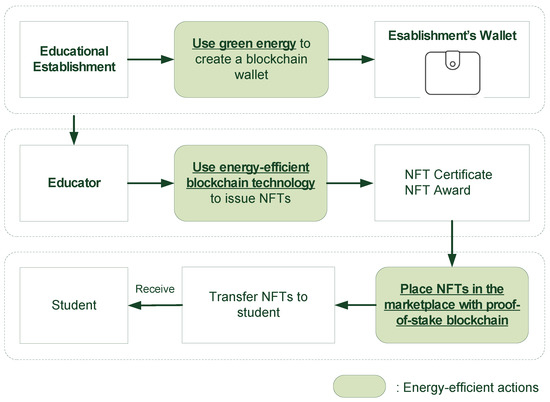
Figure 15.
The proposed energy-efficient educational NFT establishment system.
From the above analysis, it can be concluded that the greatest value of combining with NFTs is to transform real-world objects into virtual ones. Progress and creativity in education have also been observed. NFT applications are not only limited to the purchase and sale of artwork but can also be expanded to the level of certificates, awards, and scholarships, making the process of education swifter and more convenient.
However, people still love real products that can be touched. More research is required to propose ways to balance the development of technology and energy and to enable most people to accept the combination of education with NFTs.
Funding
This research was funded by National Science and Technology Council with grant number [MOST 110-2511-H-142 -008 -MY2].
Institutional Review Board Statement
Not applicable.
Informed Consent Statement
Not applicable.
Data Availability Statement
Not applicable.
Conflicts of Interest
The authors declare no conflict of interest.
References
- Elmessiry, A.; Elmessiry, M.; Bridgesmith, L. NFT student teacher incentive system (NFT-stis). SSRN Electron. J. 2021, 4648–4656. [Google Scholar] [CrossRef]
- Wu, C.-H.; Liu, C.-H.; Huang, Y.-M. The exploration of continuous learning intention in STEAM education through attitude, motivation, and cognitive load. Int. J. STEM Educ. 2022, 9, 1–22. [Google Scholar] [CrossRef]
- Wu, C.H.; Lin, H.-C.K.; Wang, T.-H.; Huang, T.-H.; Huang, Y.-M. Affective Mobile Language Tutoring System for Supporting Language Learning. Front. Psychol. 2022, 13, 833327. [Google Scholar] [CrossRef]
- Abdullah, A.H.; Julius, E.; Suhairom, N.; Ali, M.; Talib, C.A.; Ashari, Z.M.; Kohar, U.H.A.; Rahman, S.N.S.A. Relationship between Self-Concept, Emotional Intelligence and Problem-Solving Skills on Secondary School Students’ Attitude towards Solving Algebraic Problems. Sustainability 2022, 14, 14402. [Google Scholar] [CrossRef]
- Wu, C.-H.; Huang, Y.-M.; Hwang, J.-P. Review of affective computing in education/learning: Trends and challenges. Br. J. Educ. Technol. 2015, 47, 1304–1323. [Google Scholar] [CrossRef]
- Wilson, K.B.; Karg, A.; Ghaderi, H. Prospecting non-fungible tokens in the digital economy: Stakeholders and ecosystem, risk and opportunity. Bus. Horizons 2021, 65, 657–670. [Google Scholar] [CrossRef]
- Hofstetter, R.; de Bellis, E.; Brandes, L.; Clegg, M.; Lamberton, C.; Reibstein, D.; Rohlfsen, F.; Schmitt, B.; Zhang, J.Z. Crypto-marketing: How non-fungible tokens (NFTs) challenge traditional marketing. Mark. Lett. 2022, 33, 705–711. [Google Scholar] [CrossRef]
- LEDU. 2021. Available online: https://ledu.educationecosystem.com/top-10-use-cases-of-nft-in-education/ (accessed on 20 March 2022).
- Lizcano, D.; Lara, J.A.; White, B.; Aljawarneh, S. Blockchain-based approach to create a model of trust in open and ubiquitous higher education. J. Comput. High. Educ. 2020, 32, 109–134. [Google Scholar] [CrossRef]
- Dowling, M. Fertile LAND: Pricing non-fungible tokens. Financ. Res. Lett. 2021, 44, 102096. [Google Scholar] [CrossRef]
- Thusi, N.; Costa, K. A Practical Representation of NFT Pedagogy in a Learning Environment. 2020. Available online: https://osf.io/preprints/africarxiv/pjxvd/ (accessed on 30 November 2022).
- DelSignore, P. 2021. Available online: https://medium.com/the-future-of-learning-and-education/nfts-in-education-957ce434047c (accessed on 18 March 2022).
- Khan, U.; An, Z.Y.; Imran, A. A Blockchain Ethereum Technology-Enabled Digital Content: Development of Trading and Sharing Economy Data. IEEE Access 2020, 8, 217045–217056. [Google Scholar] [CrossRef]
- Kuleto, V.; Bucea-Manea-Țoniş, R.; Bucea-Manea-Țoniş, R.; Ilić, M.P.; Martins, O.M.D.; Ranković, M.; Coelho, A.S. The Potential of Blockchain Technology in Higher Education as Perceived by Students in Serbia, Romania, and Portugal. Sustainability 2022, 14, 749. [Google Scholar] [CrossRef]
- Palma, L.M.; Vigil, M.A.G.; Pereira, F.L.; Martina, J.E. Blockchain and smart contracts for higher education registry in Brazil. Int. J. Netw. Manag. 2019, 29, e2061. [Google Scholar] [CrossRef]
- Deenmahomed, H.A.M.; Didier, M.M.; Sungkur, R.K. The future of university education: Examination, transcript, and certificate system using blockchain. Comput. Appl. Eng. Educ. 2021, 29, 1234–1256. [Google Scholar] [CrossRef]
- Capece, G.; Ghiron, N.L.; Pasquale, F. Blockchain Technology: Redefining Trust for Digital Certificates. Sustainability 2020, 12, 8952. [Google Scholar] [CrossRef]
- Chen, Y. The Impact of Artificial Intelligence and Blockchain Technology on the Development of Modern Educational Technology. Mob. Inf. Syst. 2022, 2022, 1–12. [Google Scholar] [CrossRef]
- Panagiotidis, P. Blockchain in Education—The Case of Language Learning. Eur. J. Educ. 2022, 5, 66–82. [Google Scholar] [CrossRef]
- Alammary, A.; Alhazmi, S.; Almasri, M.; Gillani, S. Blockchain-Based Applications in Education: A Systematic Review. Appl. Sci. 2019, 9, 2400. [Google Scholar] [CrossRef]
- Bucea-Manea-Țoniş, R.; Martins, O.M.D.; Bucea-Manea-Țoniş, R.; Gheorghiță, C.; Kuleto, V.; Ilić, M.P.; Simion, V.-E. Blockchain Technology Enhances Sustainable Higher Education. Sustainability 2021, 13, 12347. [Google Scholar] [CrossRef]
- Ante, L. Non-fungible token (NFT) markets on the Ethereum blockchain: Temporal development, cointegration and interrelations. Econ. Innov. New Technol. 2022, 1–19. [Google Scholar] [CrossRef]
- Kaczynski, S.; Kominers, S.D. How NFTs create value. Harv. Bus. Rev. 2021, 10. [Google Scholar]
- Chohan, R.; Paschen, J. NFT marketing: How marketers can use nonfungible tokens in their campaigns. Bus. Horizons 2021. [Google Scholar] [CrossRef]
- Morkunas, V.J.; Paschen, J.; Boon, E. How blockchain technologies impact your business model. Bus. Horiz. 2019, 62, 295–306. [Google Scholar] [CrossRef]
- Cheriguene, A.; Kabache, T.; Kerrache, C.A.; Calafate, C.T.; Cano, J.C. NOTA: A novel online teaching and assessment scheme using Blockchain for emergency cases. Educ. Inf. Technol. 2021, 27, 115–132. [Google Scholar] [CrossRef] [PubMed]
- Griffin, J. Learning science through practical experiences in museums. Int. J. Sci. Educ. 1998, 20, 655–663. [Google Scholar] [CrossRef]
- Mullen, J.; Byun, C.; Gadepally, V.; Samsi, S.; Reuther, A.; Kepner, J. Learning by doing, High Performance Computing education in the MOOC era. J. Parallel Distrib. Comput. 2017, 105, 105–115. [Google Scholar] [CrossRef]
- Tran, T.A.; James, H.; Pittock, J. Social learning through rural communities of practice: Empirical evidence from farming households in the Vietnamese Mekong Delta. Learn. Cult. Soc. Interact. 2018, 16, 31–44. [Google Scholar] [CrossRef]
- Liang, X.; Zhao, Q.; Zhang, Y.; Liu, H.; Zhang, Q. EduChain: A highly available education consortium blockchain platform based on Hyperledger Fabric. Concurr. Comput. Pr. Exp. 2021, e6330. [Google Scholar] [CrossRef]
- Zanella, G.; Liu, C.Z.; Choo, K.-K.R. Understanding the Trends in Blockchain Domain Through an Unsupervised Systematic Patent Analysis. IEEE Trans. Eng. Manag. 2021, 1–15. [Google Scholar] [CrossRef]
- Savelyev, A. Copyright in the blockchain era: Promises and challenges. Comput. Law Secur. Rev. 2018, 34, 550–561. [Google Scholar] [CrossRef]
- Bamakan, S.M.H.; Nezhadsistani, N.; Bodaghi, O.; Qu, Q. Patents and intellectual property assets as non-fungible tokens; key technologies and challenges. Sci. Rep. 2022, 12, 1–13. [Google Scholar] [CrossRef]
- Shin, D.D. Blockchain: The emerging technology of digital trust. Telemat. Inform. 2019, 45, 101278. [Google Scholar] [CrossRef]
- Sanders, R. UC Berkeley Will Auction NFTs of Nobel Prize-Winning Inventions to Fund Research. Berkeley News. 2021. Available online: https://news.berkeley.edu/2021/05/27/uc-berkeley-will-auction-nfts-of-nobel-prize-winning-inventions-to-fund-research/ (accessed on 10 November 2022).
- Tsang, Y.P.; Wu, C.H.; Lee, C.K.M. BlockTrainHK: An online learning game for experiencing blockchain concepts. SoftwareX 2022, 19, 101167. [Google Scholar] [CrossRef]
- Dowling, M. Is non-fungible token pricing driven by cryptocurrencies? Financ. Res. Lett. 2022, 44, 102097. [Google Scholar] [CrossRef]
- Wang, T. A Deep Learning-Based Programming and Creation Algorithm of NFT Artwork. Mob. Inf. Syst. 2022, 2022, 1–10. [Google Scholar] [CrossRef]
- Ahmadisheykhsarmast, S.; Sonmez, R. A smart contract system for security of payment of construction contracts. Autom. Constr. 2020, 120, 103401. [Google Scholar] [CrossRef]
- Williams, P. Does competency-based education with blockchain signal a new mission for universities? J. High. Educ. Policy Manag. 2018, 41, 104–117. [Google Scholar] [CrossRef]
- Ngoasheng, C.; Ngoepe, M.; Marutha, N.S. Sounds like a broken record: Preservation and access of audio-visual records at the South African broadcasting corporation radio. Glob. Knowledge Mem. Commun. 2021, 71, 383–397. [Google Scholar] [CrossRef]
- Rakemane, D.; Mosweu, O. Challenges of managing and preserving audio-visual archives in archival institutions in Sub Saharan Africa: A literature review. Collect. Curation 2020, 40, 42–50. [Google Scholar] [CrossRef]
- Thomas, P. 2021. Available online: https://medium.com/@peterjthomas/nfts-in-education-fashion-fad-or-truly-non-fungible-252a662d4bce (accessed on 30 May 2022).
- StartupBeat. Hong Kong Economic Journal Financial News. 2022. Available online: https://www1.hkej.com/features/article?q=%23%E8%99%9B%E5%B9%A3%E5%8B%95%E6%85%8B%23&suid=451160638 (accessed on 30 November 2022).
- Johnson, S. How Will NFTs Disrupt the Education Sector? Cyptocurrency. 2022. Available online: https://biz.crast.net/how-will-nfts-disrupt-the-education-sector/ (accessed on 12 November 2022).
- Bambury, S. 3 Ways NFTs Will Disrupt the Education Sector. 2022. Available online: https://www.gesseducation.com/gess-talks/articles/3-ways-nfts-will-disrupt-the-education-sector (accessed on 30 November 2022).
- Vilchis, N. How Do NFTs Support Education? Institute for the Future of Education. 2022. Available online: https://observatory.tec.mx/edu-news/how-do-nfts-support-education (accessed on 30 November 2022).
- Cheng, J. 2021. Available online: https://www.eduloco.com/blog/how-nft-metaverse-will-accelerate-virtual-education/ (accessed on 15 March 2022).
- V, C. Yahoo News. 2022. Available online: https://tw.news.yahoo.com/%E8%87%BA%E8%97%9D%E54%A7%E9%BC%93%E5%8B%B5%E5%AD%B8%E7%94%9F%E8%87%AA%E7%94%B1%E5%89%B5%E4%BD%9C%E7%99%BC%E8%A1%8Cnft-114730350.html (accessed on 22 May 2022).
- Hong, S.T. China Times News Network. 2022. Available online: https://www.chinatimes.com/realtimenews/20220407001850-260405?ctrack=pc_main_rtime_p05&chdtv&fbclid=IwAR1EGTz12fAmjIwHHR2Ic-HZlZFFg_95GKbhB8_PC3z_jlmQWTd9iNSo4ao (accessed on 10 April 2022).
- NFTBoard. 2022. Available online: https://nftboard.today/nftboard-gust-and-her-friends/ (accessed on 31 March 2022).
- Zeedz. 2022. Available online: https://www.zeedz.io/?gclid=CjwKCAjwtp2bBhAGEiwAOZZTuMlh8i_YdxJRJathsn16pvMsI3-c0reWhnVSQIRLuG9HpDeQoGjDHhoC9FgQAvD_BwE (accessed on 30 November 2022).
- Investopedia. Do Non-Fungible Tokens (NFTs) Harm the Environment? 2022. Available online: https://www.investopedia.com/nfts-and-the-environment-5220221 (accessed on 10 November 2022).
Disclaimer/Publisher’s Note: The statements, opinions and data contained in all publications are solely those of the individual author(s) and contributor(s) and not of MDPI and/or the editor(s). MDPI and/or the editor(s) disclaim responsibility for any injury to people or property resulting from any ideas, methods, instructions or products referred to in the content. |
© 2022 by the authors. Licensee MDPI, Basel, Switzerland. This article is an open access article distributed under the terms and conditions of the Creative Commons Attribution (CC BY) license (https://creativecommons.org/licenses/by/4.0/).